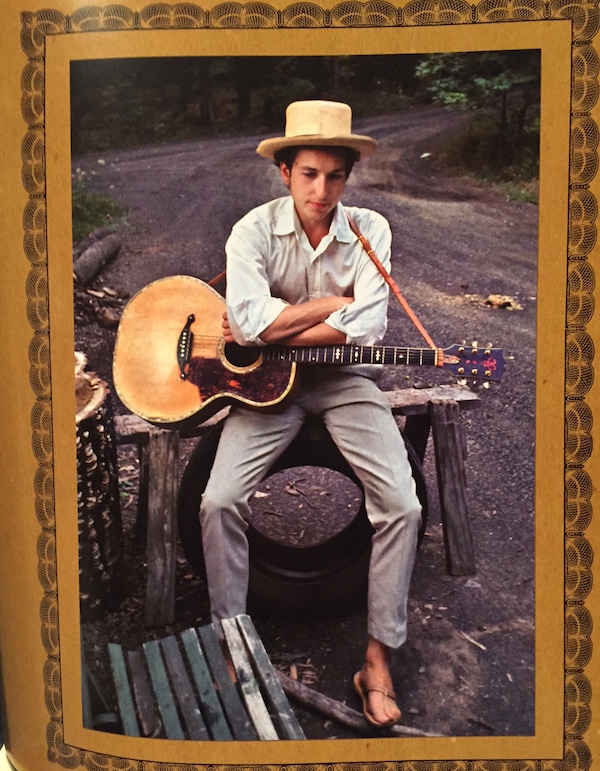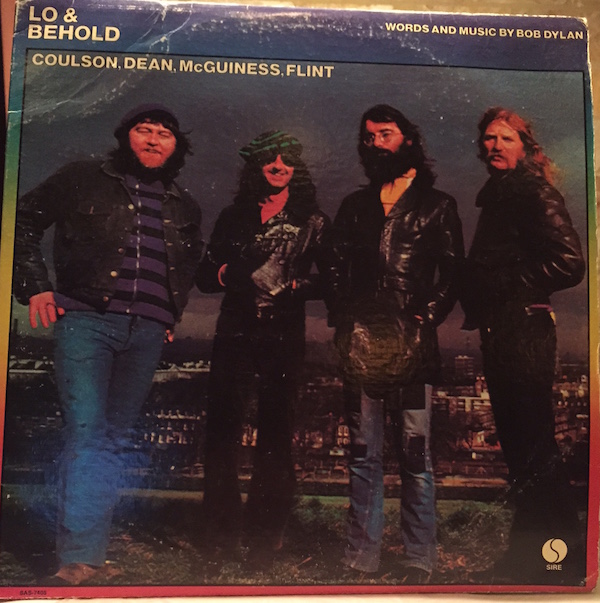Dylan and The Band's The Basement Tapes Raw Presents The Authentic Document
Plenty of people I know think The Basement Tapes are “a bunch of unreleased songs Dylan and The Band sang together at 'Big Pink' that were never released but bootleggers forced their release in 1975 as The Basement Tapes".
How many know that the 1975 release was of the songs seriously revised with Garth Hudson’s wide stage recording summed to mono and overdubs placed against the wide-open space?
That’s trivia compared to the story so well told in the full sized book’s annotation by Sid Griffin, written last July 2014. Griffin recounts and contextualizes the story in a way that even those who know parts or even all of it will follow eagerly along with his narrative. Those who don’t know any of this will leave the building fully up to speed and then some.
A film treatment summary would be: Dylan has a motorcycle accident, moves upstate New York to recover, disappears, has an attitude adjustment, invites his touring band still under contract to join him upstate, the group soon to be known as The Band goes.
Drawing from long forgotten obscure country music and the singer's literary heroes, for a few months they make magical, spontaneous music, fortunately documented on tape (“on a Revox A-77” some audiophiles would add).
The treatment’s second act: Dylan prepares a tape of songs he never intended to release and sends it to a music publisher, which results in covers of unfamiliar Dylan songs appearing on Top 40 radio and beyond—mostly in the U.K. “Quinn the Eskimo”, first covered by Manfred Mann is probably the most well-known cover but, Fairport Convention, The Byrds, Rod Stewart and many others also cover the songs. (Detour: in 1972 Coulson, Dean, McGuiness, Flint release Lo and Behold [Sire SAS 7405] a thoroughly captivating, sonically outstanding album of mostly “Basement Tape Obscurites”) mastered in America by Bob Ludwig.
Bootleggers get ahold of the tape and release it on vinyl. The Bootleg record industry is born! More songs from the recordings surface. Worldwide demand grows for an “official” release of “The Basement Tapes.”
Dylan and Columbia Records relent and release a double LP set but not before The Band returns to the studio with the tapes, folds them down to mono and adds overdubs to produce a more palatable, commercial product. Despite the relatively primitive production, it is a commercial sensation! (“that was recently reissued on vinyl by Mobile Fidelity and it sounds amazing!” some audiophiles would add).
Cut to thirty nine years after the “Basement Tapes”'s first release. With Garth Hudson’s assistance, in a Toronto studio his original 7.5 IPS ¼ track tapes are carefully restored, digitized and compiled for yet another release, this time as complete as possible including unfinished songs and snippets and more importantly as the songs were originally recorded. Even casual Dylan fans know some of them: “Million Dollar Bash”, “Tears of Rage,” “Nothing Was Delivered”, “You Ain’t Goin’ Nowhere,” “This Wheel’s On Fire” and “Tears of Rage” among them.
The songs on the release are in three states described in the notes as “restored” (as in songs issued on the original “Basement Tapes” double LP but here restored to their original state after having been summed to mono with reverb added), “Without Overdubs” (as in tracks issued on the original “Basement Tapes” now with overdubs removed), “Alternative Version” (as in a different performance of a song included on the original “Basement Tapes”) and “Unreleased” (as in tracks either never released on the 1975 “Basement Tapes” or never previously released by Bob Dylan).
The release comes in three versions: The Basement Tapes Complete (5 CDs), The Basement Tapes Raw: The Bootleg Series Vol. 11 Presents Highlights From The Basement Tapes Complete (2 CDs and 3 LPs in a box set that includes the 2 CDs).
Cut to a picture of the 3 LP box set:

Are you buying one of Neil’s “fashion statements” by buying this digitally sourced vinyl box set? Absolutely not and here’s why: the producers have guaranteed you a good, tactile, visual and sonic time down to the way the word “RAW” on the box’s cover shines like the piece of tape it’s supposed to be.
Everything about the box is “bespoke” as the say in the U.K. Nothing’s been blown up from the CD set. Each of the 180g LPs comes in a unique double cardboard sleeve, each reproducing an iconic vintage audio brand. One is an “audiodisc’ outer sleeve that geezers are sure to recognize along with the “audiodisc” label familiar to anyone who stepped into a booth at Coney Island or any other ‘50s and ‘60s era amusement park and recorded a few minutes to a disc that magically dropped a few minutes later from a slot and having a particular and magical smell that some of you are smelling right now. The record is in a heavy green inner sleeve that will also be familiar to some.

The second record jacket reproduces one from “Presto Recording Company” of Decatur, IL complete with “Dismorphic Recording Blank” label. The third is from “Technique Spatio-dynamic Sound Design” (a new one on me) complete with red and white “Spatio-dynamic” label. The CD sleeves reproduce reels of Scotch 111 and the familiar (to some) green Shamrock recording tape.
But the real treasure is the full-sized full color book, which is again produced specifically for this box. Read Sid Griffin’s annotation and admire the photos like a human being reading a book not like some slave fumbling with a “booklet”, whose tiny pages don’t separate sufficiently to read the words close to the spine unless you break its back and whose photos are puny, poor reproductions of the real art. Genuine care went into each page’s design. Go ahead! Have a real experience and if you want to make a “fashion statement”, sit down and play the records while reading the annotation, Ben Rollins’ song by song revelations and notes about the tapes and their restoration all the while delighting in the images of tape boxes and reels, deep photos—and do it wearing a tuxedo or your underpants.

P.S.: Anyone who still thinks Dylan can’t sing (and had I not read some of the comments posted under the Shadows in the Night review I wouldn’t have believed there was anyone left) should listen to the incomplete “Baby, Won’t You be My Baby” followed by “Sign of the Cross”. When Dylan’s voice tears open during “Sign of the Cross”, well you’ve never heard such beautiful, soulful and meaningful ugliness!
Again, the vinyl sound, from whatever resolution digital it was sourced, sounds three-dimensional and “live” while the CDs just sound soft, flat and uninvolving. If that’s the result of “additive distortions”,I’ll happily take them. Ryan Smith mastered the LP edition and whatever he did to the source material makes it far more vibrant and alive than are the CDs.
Look, these are ‘lo-fi’ recordings in the best sense of the phrase. What they lack in frequency extension is often more than made up for by their natural, unprocessed ease and sense of time and place. In one way they are the opposite of “transparent” as in “you are there” but in another way it sounds as if you are there, just displaced through time. And after listening to the three well-pressed records while reading the annotation and song by song play by play, and enjoying the visual and tactile pleasures of this box set, anyone who doesn’t think he or she has already gotten his or her money’s worth and come away after that first listen with a deeper and more fulfilling understanding of these extraordinary songs and their unlikely and amazing history, or who senses “vinyl cynicism” in the presentation, well they need to listen again or until they do.
Getting to the end of the first listen and read-through was like closing and simultaneously opening a book on a long familiar story.





